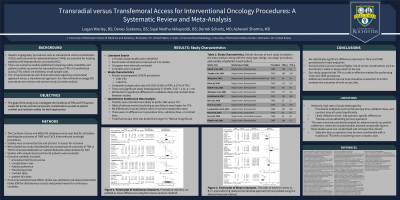Radioembolization
(32) Transradial versus Transfemoral Access for Interventional Oncology Procedures: A Systematic Review and Meta-Analysis
Saturday, September 23, 2023
6:00 PM - 7:30 PM East Coast USA Time

Denes Szekeres, BS – Medical Student, URMC; Sajal Akkipeddi, BS – Medical Student, URMC; Derrek Schartz, MD – Radiology Resident, URMC; Ashwani Sharma, MD – Attending Physician, URMC
Purpose: The procedural and clinical outcomes of a transradial approach (TRA) versus a transfemoral approach (TFA) for interventional oncology (IO) procedures remain unclear.
Material and Methods: The Cochrane Library and MEDLINE databases were searched for all studies detailing the outcomes of IO procedures. This meta-analysis included any study that detailed outcomes of chemoembolization or radioembolization interventions for any tumor, while studies with sample sizes less than 50 patients were excluded. Outcomes considered included procedural technical success, complication rates, patient preference, fluoroscopy time, and patient skin dose. An inverse variance fixed effects model was utilized to calculate pooled odds ratios (OR) for dichotomous results and pooled means for continuous variables.
Results: Out of 147 studies initially found, 12 met the criteria, involving 1,501 TRA and 1,298 TFA patients. TRA was associated with a significantly lower rate of technical success compared to TFA [OR: 0.22; 95% Confidence Interval (CI): 0.05 to 0.86, P = 0.03; I2 = 0%]. However, TRA was also associated with an overall lower rate of complications [OR: 0.41; CI: 0.21 to 0.79, P=0.008; I2=27%] and was more often preferred by patients [OR: 97.1; CI: 49 to 192, P < 0.00001; I2=93%]. No significant difference was found in mean patient skin dose between TRA (411 +/-? Gy/cm2) and TFA (397 Gy/cm2) (P=0.40) or in fluoroscopy time between TRA and TFA (1.37 min) [CI: -0.39 to 3.12 min, P=0.13].
Conclusions: While TRA is associated with a lower technical success rate for IO chemoembolization and radioembolization procedures compared to TFA, TRA is also associated with a significantly lower rate of complications and higher patient preference rate without differences in radiation dose or fluoroscopy time.
Material and Methods: The Cochrane Library and MEDLINE databases were searched for all studies detailing the outcomes of IO procedures. This meta-analysis included any study that detailed outcomes of chemoembolization or radioembolization interventions for any tumor, while studies with sample sizes less than 50 patients were excluded. Outcomes considered included procedural technical success, complication rates, patient preference, fluoroscopy time, and patient skin dose. An inverse variance fixed effects model was utilized to calculate pooled odds ratios (OR) for dichotomous results and pooled means for continuous variables.
Results: Out of 147 studies initially found, 12 met the criteria, involving 1,501 TRA and 1,298 TFA patients. TRA was associated with a significantly lower rate of technical success compared to TFA [OR: 0.22; 95% Confidence Interval (CI): 0.05 to 0.86, P = 0.03; I2 = 0%]. However, TRA was also associated with an overall lower rate of complications [OR: 0.41; CI: 0.21 to 0.79, P=0.008; I2=27%] and was more often preferred by patients [OR: 97.1; CI: 49 to 192, P < 0.00001; I2=93%]. No significant difference was found in mean patient skin dose between TRA (411 +/-? Gy/cm2) and TFA (397 Gy/cm2) (P=0.40) or in fluoroscopy time between TRA and TFA (1.37 min) [CI: -0.39 to 3.12 min, P=0.13].
Conclusions: While TRA is associated with a lower technical success rate for IO chemoembolization and radioembolization procedures compared to TFA, TRA is also associated with a significantly lower rate of complications and higher patient preference rate without differences in radiation dose or fluoroscopy time.
